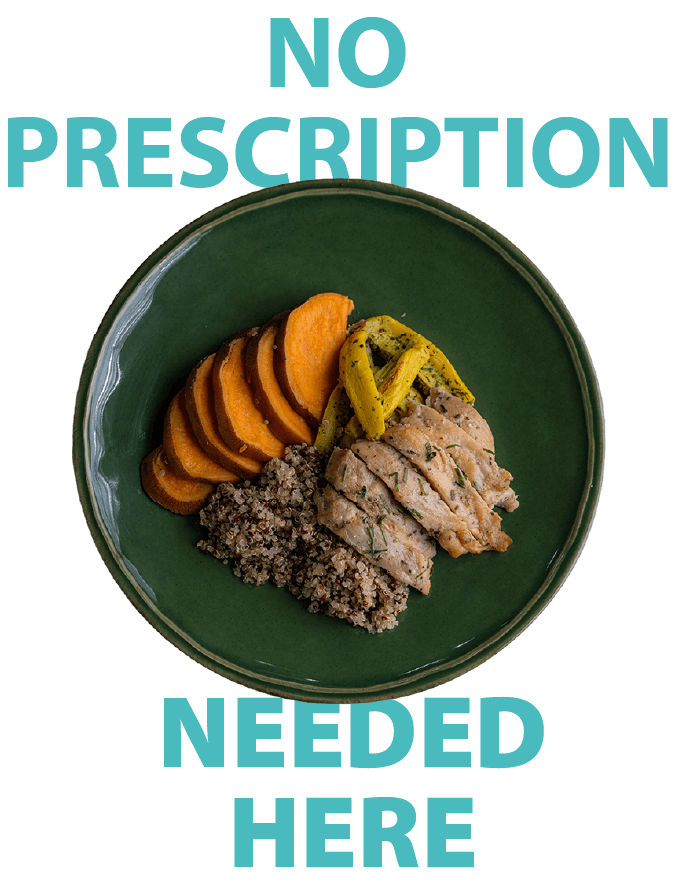Home Page
Medically
Curated Meals
Designed by a Team of Physicians and Registered Dietitian
Nutritionists to Meet the Needs of Your Medical Diet.
The MDMeals Line-up:


Medically Prepared Meals in 3 Easy Steps
- Order in our secure website choosing from one of the many options
- Your selected meals are cooked in our own manufacturing kitchen
- Your meals are delivered to your front door and are ready to be enjoyed in the leisure of your home


Supporting First Responders
(Firemen, Policemen, EMT’s and Nurses)
Frequently Asked Questions
For healthy adults, eating a variety of food rich in fruits and vegetables and high in fiber with calories that match their needs and limiting saturated fat, sugar, and salt will be the general rule. Evidence suggested that dietary patterns in adults that involved higher consumption of vegetables, fruits, legumes, nuts, whole grains, unsaturated vegetable oils, fish, and lean meat or poultry were associated with a decreased risk of all-cause mortality.
For people with chronic medical conditions, the right approach is to follow the recommendations of their physician and dietitian. MDMeals will help you follow these recommendations by preparing meals that match your medical condition and delivering them directly to you.
Cardiovascular disease remains the leading cause of death in most developed countries, and it includes four components:
Coronary artery disease can present as myocardial infarction or angina.
Cerebrovascular disease can present as a stroke
Peripheral artery disease can present as intermittent claudication
Aortic atherosclerosis and thoracic or abdominal aortic aneurysm
Besides genetic causes, high cholesterol, diabetes, hypertension, obesity, and smoking are the most critical risk factors for developing cardiovascular disease. A healthy diet can decrease your risk of developing cardiovascular disease by preventing or modifying most of these risk factors. Besides weight control, exercise, and smoking cessation, a healthy diet is an essential tool to modify these risk factors, which can also help control the disease process and decrease the risk of complications
Understanding the different types of cholesterol is crucial. High blood cholesterol, particularly LDL, can significantly increase your risk of heart disease, stroke, and other health issues. On the other hand, HDL can lower these risks. Triglyceride, while not cholesterol, is another type of fat that can also increase your risks.
There are many ways to improve your cholesterol, triglyceride levels, and health. These are primarily through appropriate diet, exercise, and sometimes medications if recommended by your physician. Improving and treating other risk factors like diabetes, high blood pressure, overweight, and smoking can also significantly enhance your risks and have a great impact on your health.
What are the ABCs of Diabetes?
Managing these three areas can help lower the risk of heart attack, stroke, and the progression of diabetes complications.
A is A1C. This measure extrapolates average blood sugar expressed as a percentage. This evaluation is generally measured every three months; targets are typically less than 7%.
B is blood pressure; the higher this is, the harder the heart has to work. High blood pressure and diabetes are the leading causes of kidney disease.
C is cholesterol, the amount of lipids in the blood. Commonly measured forms are Total Cholesterol, HDL, LDL, and Triglycerides.
The MD MEALS diabetes meal standards were designed with the ABCs in mind.
A1C—The most abundant evidence for improved glycemia and A1C reductions comes from dietary patterns that reduce carbohydrate intake and provide adequate fiber.
Blood pressure - Reduced sodium and adequate potassium-rich foods can support blood pressure reductions.
Cholesterol - Diets low in saturated fat, adequate soluble fiber, plant sterols, and omega-3 fatty acids all have strong evidence to support improved cholesterol levels. References:
Nutrition Therapy for Adults With Diabetes or Prediabetes: A Consensus Report Control the ABCs of Diabetes (NHLBI)There is no one-size-fits-all dietary pattern that will be appropriate, best or works for everyone. The key is selecting a dietary pattern that aligns with the outcome you want to achieve while considering any co-existing health conditions. This is where talking with a Registered Dietitian can help provide guidance on what to consider.
You may be looking to improve body composition, improve performance, reduce the risk for cardiovascular disease or diabetes, or manage a current condition like gout. All diets differ in how much protein, carbohydrates, and fat they contain, as well as specific recommended foods.
Without a personalized recommendation from a dietitian, the diabetes plate method can be a great option that works for many. It promotes fullness and satiety and makes it easier to manage weight by emphasizing fiber, lean proteins, and vegetables.
The American Diabetes Association recommends starting with a plate about 9 inches across. First, fill half your plate with nonstarchy vegetables, one-quarter with lean protein foods, and the the remaining quarter with carbohydrates.
At MD Meals, we use the ADA consensus statement on nutrition therapy for adults and diabetes to translate the standards more accurately to complete nutrient analysis for our various diabetes-friendly meals. Without nutrient analysis software, the simple plate method will provide an accessible template for general health needs.
References:
What is the Diabetes Plate Method?
ADA consensus - nutrition therapy for adults with diabetesCaloric intake for weight loss depends on various factors; as you may have expected, this should be individualized. Indirect calorimetry is preferred to calculate a baseline metabolic rate, but these are not commonplace. Using the Mifflin-St. Jeor equation is the preferred formula for calculating a starting caloric target. This is multiplied by an energy factor. Typically 1.3. According to an evidence analysis review by the Academy of Nutrition and Dietetics, this formula is more accurate at predicting resting metabolic rates in overweight or obese adults. The caloric deficit needed varies but subtracting 500 calories from the result is a good place to start.
As an alternative, the NIDDKD has a bodyweight planner (niddk.nih.gov/bwp) that can be used to calculate estimated starting energy needs.
The caloric intake average and change in weight should be evaluated each week. Greater initial weight loss in the first 1-2 months strongly predicts later total weight loss.
References:
Jena Shaw Tronieri, PhD, Thomas A Wadden, PhD, Ariana M Chao, PhD, CRNP, Rebecca L Pearl, PhD, Naji Alamuddin, MD, Robert I Berkowitz, MD, Early Weight Loss in Behavioral Treatment Predicts Later Rate of Weight Loss and Response to Pharmacotherapy, Annals of Behavioral Medicine, Volume 53, Issue 3, March 2019, Pages 290–295, https://doi.org/10.1093/abm/kay036
Hall KD. What is the required energy deficit per unit weight loss? Int J Obes (Lond). 2008 Mar;32(3):573-6. doi: 10.1038/sj.ijo.0803720. Epub 2007 Sep 11. PMID: 17848938; PMCID: PMC2376744.
Role of Physical Activity for Weight Loss and Weight Maintenance (NIH)
When deciding how much and what sources of carbohydrates to consume, there are a few things to consider. Carbohydrates include fiber, complex carbohydrates, and sugars. Carbohydrates are found in fruits, vegetables, legumes, grains, and dairy. These foods also contain important vitamins and minerals that are difficult to get from the remaining food groups adequately. The first question I ask when someone wants to make a specific significant change to their diet is what outcome they hope to achieve. Second, what foods would be cut from the diet, and what would be added to fill the void? This aids in appropriately assessing how the overall quality of the diet will be impacted, what nutrients may be inadequate or excessive, and, importantly, if the intervention is likely to be sustainable, assuming the change would contribute to progress toward the desired outcome.
Nutrition Therapy for Adults With Diabetes or Prediabetes: A Consensus Report cites that there is no ideal percentage of calories from carbohydrates, protein, and fat for all people. This should be individualized based on current eating patterns, preferences, and metabolic goals. Reducing total carbohydrate intake while achieving adequate fiber is associated with a reduced A1C. However, high fiber dietary intake >50g/day is only associated with a modest reduction in A1c of 0.2-0.3%. The report summarizes by stating, “Carbohydrate intake should emphasize nutrient-dense carbohydrate sources that are high in fiber and minimally processed. Eating plans should emphasize nonstarchy vegetables, fruits, legumes, whole grains, and dairy products, with minimal added sugars.”
References:
Nuha A. ElSayed, Grazia Aleppo, Vanita R. Aroda, Raveendhara R. Bannuru, Florence M. Brown, Dennis Bruemmer, Billy S. Collins, Marisa E. Hilliard, Diana Isaacs, Eric L. Johnson, Scott Kahan, Kamlesh Khunti, Jose Leon, Sarah K. Lyons, Mary Lou Perry, Priya Prahalad, Richard E. Pratley, Jane Jeffrie Seley, Robert C. Stanton, Deborah Young-Hyman, Robert A. Gabbay; on behalf of the American Diabetes Association, 5. Facilitating Positive Health Behaviors and Well-being to Improve Health Outcomes: Standards of Care in Diabetes—2023. Diabetes Care 1 January 2023; 46 (Supplement_1): S68–S96. https://doi.org/10.2337/dc23-S005
Gluten is a protein found in the endosperm of wheat, barley, and rye. Celiac is the primary diagnostic reason to remove gluten from the diet. Wheat allergy, non-celiac gluten sensitivity (NCGS), and fructan eliminations as part of a FODMAP elimination for irritable bowel diseases also limit gluten-containing foods but are not mutually exclusive to gluten.
Gluten-containing foods contain fermentable carbohydrates, but other non-gluten-containing foods also contain fructans, like onions and garlic. In a placebo-controlled crossover re-challenge study, gastrointestinal symptoms improved during reduced FODMAP intake, and worsening symptoms with the administration of gluten protein were only observed in 8% of the subjects, but after a reduced FODMAP intake, they found no evidence of worsening symptoms from gluten alone. In another study, patients with self-reported NCGS GI were given bars with hidden gluten, fructan, or a placebo.
There was no difference between the placebo and the gluten group, but GI symptoms measured on the Gastrointestinal Symptom Rating Scale Irritable Bowel Syndrome ( GSRS-IBS) were highest with fructan consumption.
From a weight management perspective, initially, this may result in a weight reduction due to decrease calorie consumption. Many high-caloric-density foods in our environmen,t primarily provide fat calories and gluten-containing foods. Cake, cookies, crackers, pasta, sandwiches, and pizza are all common examples, but over time, one may find replacement items that are similar in caloric density driving calorie intake back up.
In summary, it appears for those who do not have celiac or a wheat allergy that limiting fructan-containing foods may yield better improvements in GI symptoms even with those who have self-diagnosed non-celiac gluten sensitivity.
References:
Barbaro MR, Cremon C, Stanghellini V, Barbara G. Recent advances in understanding non-celiac gluten sensitivity. F1000Res. 2018 Oct 11;7:F1000 Faculty Rev-1631. doi: 10.12688/f1000research.15849.1. PMID: 30363819; PMCID: PMC6182669.
Skodje GI, Sarna VK, Minelle IH, Rolfsen KL, Muir JG, Gibson PR, Veierød MB, Henriksen C, Lundin KEA. Fructan, Rather Than Gluten, Induces Symptoms in Patients With Self-Reported Non-Celiac Gluten Sensitivity. Gastroenterology. 2018 Feb;154(3):529-539.e2. doi: 10.1053/j.gastro.2017.10.040. Epub 2017 Nov 2. PMID: 29102613.
Biesiekierski JR, Peters SL, Newnham ED, Rosella O, Muir JG, Gibson PR. No effects of gluten in patients with self-reported non-celiac gluten sensitivity after dietary reduction of fermentable, poorly absorbed, short-chain carbohydrates. Gastroenterology. 2013 Aug;145(2):320-8.e1-3. doi: 10.1053/j.gastro.2013.04.051. Epub 2013 May 4. PMID: 23648697.